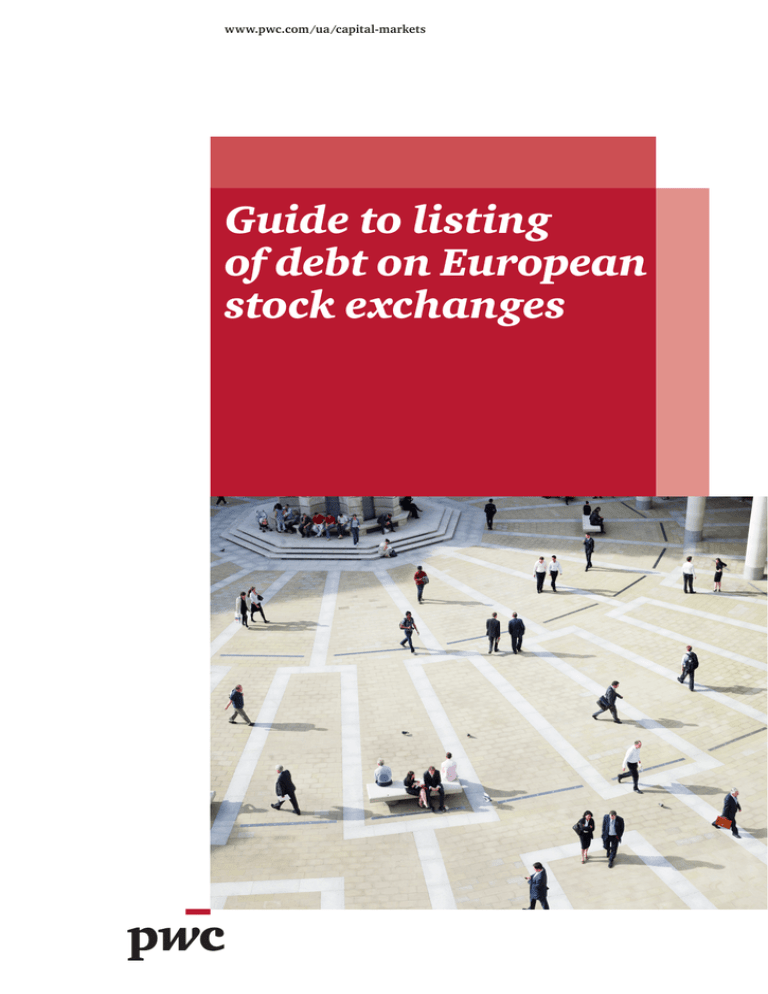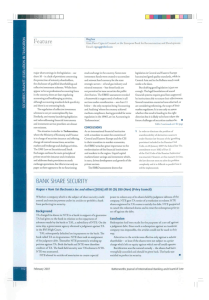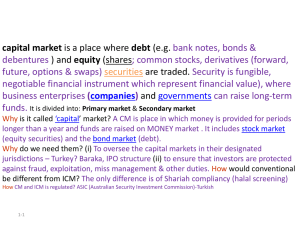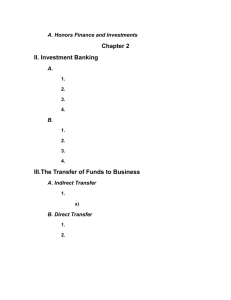
www.pwc.com/ua/capital-markets
Guide to listing
of debt on European
stock exchanges
2 PwC
A number of European stock exchanges have become
major centres for listing debt securities. The London,
Irish and Luxembourg stock exchanges are among those
with the most significant activity. This guide aims to
provide a high-level summary of the admission
requirements and continuing obligations for listing debt
securities on each of these three exchanges.
A common trait of all three exchanges
is the presence of two markets with
different features and requirements:
• An EU-regulated market with an
external regulator, in which issuers are
subject to the relevant EU Directives,
such as the Prospectus and
Transparency Directives
• An exchange-regulated market that
does not have an external regulator
and that falls outside the scope of
the relevant EU Directives
In choosing the most appropriate
exchange and market, companies
should consider the merits of each and
how they meet their overall needs, such
as funds to be raised, liquidity and so on.
Some factors to be taken into account
include:
• Investor needs
• Stock exchange fundamentals:
regulation, strategic focus and
investor relations, liquidity and
depth of capital
• Corporate image
On regulated markets, issuers are
subject to the EU Prospectus Directive.
Accordingly, investors can also obtain
a passport to other European markets
and access to international investors.
Eligibility for listing
Regardless of the stock exchange to be
used, there are certain eligibility
criteria that are common to all three
exchanges. These include:
• Free transferability of debt
securities, no restrictions on selling
securities once purchased
• Listing requirements
• Minimum initial debt offering of
EUR 200,000
• Ability/willingness to produce
IFRS accounts
• All securities of the same class must
be listed
3
Listing of debt securities
on the EU-regulated markets
The regulated markets for listing debt securities on the three exchanges
covered in this guide are:
• The Main Market (London Stock Exchange)
• The Main Securities Market (Irish Stock Exchange)
• The Bourse de Luxembourg (Luxembourg Stock Exchange)
These markets are regulated by the
corresponding regulatory authorities,
namely the Financial Services Authority
in the UK, the Irish Financial Services
Authority/Central Bank of Ireland in
Ireland and the Commission de
Surveillance du Secteur Financier
in Luxembourg. These organisations
are also the competent authorities for
approving the prospectus for debt
securities listed on these regulated
markets.
The financial reporting framework,
contents of the prospectus and the
continuing obligations of issuers are
driven by the relevant EU Directives
and Regulations, such as the Prospectus
and Transparency Directives. This guide
does not contain separate descriptions
for each of the above regulated markets,
as similar considerations apply.
4 PwC
The EU Prospectus Directive makes a
distinction between securities designed
for professional or wholesale investors
and those available to retail investors.
The distinction is largely determined by
reference to the nominal value (or face
value) of a single security. There are
some important differences between the
financial reporting framework and other
requirements for retail and wholesale
securities on regulated markets. Retail
rules apply to all securities with a
nominal value lower than the equivalent
of EUR 50,000. Wholesale rules apply to
higher denominations. In future, the
Irish and London Stock Exchanges might
adopt a higher threshold of EUR 100,000
for some ongoing obligations if such a
threshold is adopted in the Prospectus
Directive and then in the respective
countries’ legislation.
Content of the Prospectus
The Prospectus Directive and
Regulations govern the content of the
prospectus for debt securities listed on
all regulated markets within the
European Union. The key information
to be included in a prospectus,
as summarised in the table below,
applies therefore to the London, Irish
and Luxembourg regulated markets.
Presenting financial information can be
complicated and is an issue that needs
to be considered at an early stage.
Retail Investors
Wholesale Investors
Historical financial
information
Two years of audited financial information (or such shorter period that the issuer has been in operation)
Interim financial information
To be included if published since the last audited financial
statements; if audited or reviewed, then the report is to be included
Not required
Must be included if more than nine months have elapsed since
year end
Not required
Trend information
As a minimum, the most recent year’s financial information must be presented in a form consistent with that which
will be adopted in the issuer’s next published annual financial statements, taking into account the relevant
accounting standards and legislation
Statement on whether or not there has been any material adverse change in prospects since the last audited accounts
Information on trends, uncertainties, demands, commitments or
events likely to have a material effect in the current year
Significant change
Statement required for all debt securities listings
Profit forecast information
If profit forecasts are included, a statement of assumptions is required
To be reported on by auditors if profit forecasts are included
Not required
No auditor’s report required; statement by
the issuer that forecasts have been properly
prepared and the basis of accounting is
consistent with its accounting policies
Expert’s report
If a report is specifically prepared for the purposes of the prospectus, then the expert will need to consent to its inclusion
Incorporation by reference
Information may be incorporated by reference if it has been filed with the relevant regulator or the competent
authority of the issuer’s EU home member state
Continuing obligations and financial reporting
The continuing obligations for debt
issuers in EU-regulated markets are
driven by the Transparency Directive
and are generally the same across all
regulated markets. There are some
Insider information
differences in terms of continuing
obligations with respect to debt
securities depending on whether the
nominal value is less or more than
EUR 50,000. Must be disclosed to the market as soon as possible
Significant transactions must be disclosed to the market as soon as possible
Annual report and accounts
Must be approved and published within four months of the year end for retail debt issuers. As regards
wholesale issuers, must be approved and published within six months of the year end for the London
Stock Exchange and within the timeframe permitted under national legislation for the Irish Stock
Exchange, whereas there is no such requirement for Luxembourg. Annual financial statements, where
required, must be audited for both retail and wholesale issuers
Half-yearly reports
• Half-yearly reports are only required for retail debt listed on the EU-regulated markets, and must be
approved and published within two months of the period to which they relate; such interim financial
statements do not need to be audited or reviewed, but if they have been, then the audit/review report
must also be published
• Half-yearly reports are not required for wholesale debt issuers
Note 1: Issuers of debt securities listed on the Irish Stock Exchange’s Main Securities Market with a
denomination of more than EUR 100,000 (if listed after 31st December 2010) do not have to file annual and
half-yearly financial statements.
Note 2: Issuers whose home member state is Luxembourg and that have only issued debt securities with a
denomination per unit of at least EUR 50,000 are exempt from the requirement to publish financial information.
5
Listing of debt securities
on the Exchange-regulated
markets
As mentioned above, stock exchanges have also set up exchange-regulated
markets in addition to those regulated by the EU. These markets are
characterised by a less stringent regulatory regime than that of the
EU-regulated markets. They do not fall within the scope of an EU-regulated
market under the Markets in Financial Instruments Directive (“MiFID”),
and therefore the requirements of the Prospectus and Transparency
Directives do not apply.
Such markets are designed to meet the financing needs of issuers who are
looking for a sound regulatory framework but do not require a European
passport as envisaged in the Prospectus Directive. Another important
feature of these markets is that financial information does not have to be
prepared under IFRS, although IFRS financial statements may still be
preferred.
London Stock Exchange
Irish Stock Exchange
The exchange-regulated market in
London for listing debt securities is
the Professional Securities Market
(“PSM”). It is suitable for professional
investors and is outside the scope of the
EU Prospectus Directive, though certain
provisions of the Directive apply
through the relevant Listing Rules.
The distinction between wholesale
and retail markets does not apply to the
PSM, which allows securities with a
denomination under EUR 50,000 to be
offered to the wholesale market.
The exchange-regulated market of the
Irish Stock Exchange (“ISE”) is the
Global Exchange Market (“GEM”)
and is the successor market to the ISE’s
Alternative Securities Market. GEM is a
Multilateral Trading Facility as defined
in the MiFID. This market’s regulatory
regime is set out in the ISE’s Global
Exchange Market Listing and Admission
to Trading Rules. The ISE, as the
competent authority for listing in
Ireland, is responsible for approving
securities to be listed on GEM. PSM therefore provides an alternative
for issuers who do not wish to prepare
their financial information under IFRS
or equivalent accounting standards
(such as US GAAP, Canadian GAAP and
Japanese GAAP), or who wish to offer
lower denomination securities to
wholesale investors.
6 PwC
Luxembourg Stock Exchange
The exchange-regulated market of the
Luxembourg Stock Exchange is the
Euro MTF Market. The Luxembourg
Stock Exchange itself is in charge of
approving prospectuses in accordance
with its Rules and Regulations. The
Euro MTF Market is a Multilateral
Trading Facility as defined in the MiFID. Content of the Listing Particulars/Prospectus
Issuers of debt securities on the
exchange-regulated markets of the
London and Irish Stock Exchanges
do not prepare a prospectus, as per the
Prospectus Directive, but prepare listing
particulars instead. The rules of the
stock exchanges govern the content of
the listing particulars.
In the case of Luxembourg’s Euro MTF
Market, the document to be prepared is
still labelled a prospectus. Although the
Euro MTF Market, being an exchangeregulated market, falls outside the scope
of the Prospectus Directive, issuers can
choose to follow the requirements as set
out in the Prospectus Directive or the
requirements as set out in the Rules and
Regulations of the Luxembourg Stock
Exchange. Issuers in the Euro MTF
Market do not have to prepare financial
information under IFRS and national
GAAP is acceptable.
The table below summarises the key
requirements for listing particulars/
prospectuses for the three exchangeregulated markets under review.
London PSM
Irish GEM
Luxembourg Euro MTF
Historical financial
information
Two years of audited financial information (or such shorter period that the issuer has been in operation)
Interim financial
information
Not required
Trend information
Statement on whether there has been any material adverse change in prospects since the last audited accounts
As a minimum, the most recent year’s financial information must be presented in a form consistent with that which will
be adopted in the issuer’s next published annual financial statements, taking into account the relevant accounting
standards and legislation
Must be included if more than nine months have
elapsed since year end
Information on trends, uncertainties, demands, commitments
or events likely to have material effect in current year is not
required
Significant change
Statement required for all debt securities listings
Profit forecast
information
If profit forecasts are included, a statement of assumptions is
required
Information on trends, uncertainties, demands,
commitments or events likely to have material effect
in current year
If profit forecasts are included, a statement of
assumptions is required; exemption possible under the
exchange’s Rules and Regulations
No auditors’ report required; statement by the issuer that forecasts have been properly prepared and the basis of
accounting is consistent with its accounting policies
Expert’s report
If a report is specifically prepared for the purposes of the
listing particulars, then the expert will need to consent to its
inclusion
Even if a report is specifically prepared for the
purposes of the prospectus, there is no requirement for
the expert to consent to its inclusion
Continuing obligations and financial reporting
The continuing obligations for debt
issuers in exchange-regulated markets
are broadly the same as those of issuers
in EU-regulated markets, for example,
in terms of significant transactions,
insider information and so on.
Annual report and accounts
Half-yearly reports
In terms of financial information,
the table below summarises the key
requirements for issuers.
London PSM
Irish GEM
Luxembourg Euro MTF
Must be approved and published
no more than six months after
year end
Must be approved and published
within the timeframe permitted
under national legislation
Must be approved and
published within the timeframe
permitted under national
legislation
Annual financial statements must
be audited
Annual financial statements must
be audited
Annual financial statements
must be audited
Not required
Not required
Not required
Note: Issuers of debt securities on Luxembourg’s Euro MTF Market with a denomination per unit of at least EUR
50,000 are exempt from the requirement to publish financial information
7
© 2012 Limited liability company «PricewaterhouseCoopers» and/or Limited liability company Audit firm «PricewaterhouseCoopers (Audit). All rights reserved.
PwC refers to the Ukrainian member firm(s), and may sometimes refer to the PwC network. Each member firm is a separate legal entity. Please see www.pwc.com/structure for further
details.
19.09.2012






